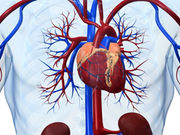Inclusion of number of vessels with CAC significantly improves capacity to predict CHD, CVD
THURSDAY, April 14, 2016 (HealthDay News) — Inclusion of the number of vessels with coronary artery calcium (CAC) improves the capacity of the Agatston CAC score to predict cardiovascular events, according to a study published online April 13 in JACC: Cardiovascular Imaging.
Michael J. Blaha, M.D., M.P.H., from the Johns Hopkins Ciccarone Center for the Prevention of Heart Disease in Baltimore, and colleagues studied 3,262 individuals with baseline CAC >0 from the Multi-Ethnic Study of Atherosclerosis. The authors examined the number of coronary vessels with CAC and classified patients according to concentrated and diffuse CAC patterns.
The researchers found that there were 368 coronary heart disease (CHD) and 493 cardiovascular disease (CVD) events during follow-up (median, 10.0 years). There was considerable heterogeneity between CAC score group and number of vessels with CAC (P < 0.01). In survival, area under the curve, and net reclassification index analyses, addition of number of vessels with CAC significantly improved capacity to predict CHD and CVD events. In participants with two or more vessels with CAC, a diffuse CAC pattern correlated with worse outcomes (hazard ratio, 1.33 to 1.41); adding this variable to the Agatston CAC score and number of vessels with CAC did not further improve risk prediction.
“The number of coronary arteries with calcified plaque, indicating increasingly ‘diffuse’ multi-vessel subclinical atherosclerosis, adds significantly to the traditional Agatston CAC score for the prediction of CHD and CVD events,” the authors write.
Full Text (subscription or payment may be required)
Copyright © 2016 HealthDay. All rights reserved.








